Part 1:
Improvements to BBC Online News:Will Trump’s tariff war spark big-bang reforms in India?
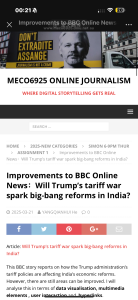
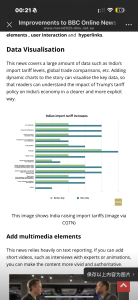
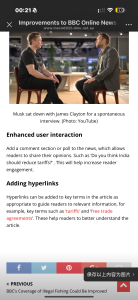
Part 2:
Between Public Trust and Policy Depth: A Comparative Analysis of BBC and The Diplomat’s Coverage of India-US Trade Tensions
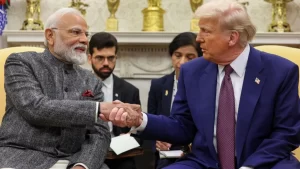
Ahead of PM Modi’s meeting with Trump in February, India cut tariffs on some US products
Introduction
This article will focus on the news of India’s trade policy direction in the US-India trade tariff conflict led by President Trump. Compare and analyze the reporting methods of two well-known online news platforms, BBC and The Diplomat. Although both articles focus on the impact of trade frictions on India’s economic strategy, they have significant differences in news style, production background and audience strategy, and thus the impact of the news is also different. This article first starts with the historical background of the two media, analyzing their differences and the reasons and impacts behind the differences.
The British Broadcasting Corporation (BBC) was founded in 1922 and is a world-renowned public service broadcasting organization headquartered in London, UK. The BBC is known for its global influence and editorial independence. As a representative of traditional media, the BBC has been providing news and entertainment to the public through radio, television and the Internet. As a public service broadcaster, the BBC is driven by public interest rather than profit. The later online news BBC News Online further expanded its influence on the online media side.
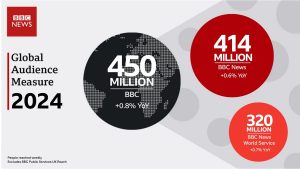
The BBC retains pole position for trust and is also ranked first for reliability and independence amongst international news providers
In contrast, The Diplomat was founded in 2002 as a purely online media-based international news magazine that focuses on studying political and economic dynamics in the Asia-Pacific region. Its main sources of funding include subscription fees and online advertising. Unlike traditional media, The Diplomat’s target audience includes scholars, policymakers and related professionals (MBFC, 2024).
Target Audience Analysis
The BBC serves a wide international audience, reaching more than 468 million people worldwide each week as of 2020 (MediaWeek,2020). It takes the public interest as its starting point and is committed to impartial public services, which is destined to diversify its audience. According to the 2022 Media Nation Report released by the British Communications Authority (Ofcom) the BBC is the most popular and trusted among British audiences for its accuracy and due impartiality. However, research and surveys show that the BBC’s online news attracts a relatively older readership, especially those over 65 years old, but at the same time the BBC has been committed to adapt to changing audience demographics (Drew, 2024).
In contrast, The Diplomat’s target readership is smaller but more influential. As a media born in the digital field and without a paper version, The Diplomat is different from the BBC, which focuses on general news. The Diplomat publishes long articles, expert columns and special reviews, which conform to the needs of some professionals and elite groups, and thus attracts many influential commentators, policymakers and professionals engaged in Asia-Pacific policy and international relations.
Comparative Story Analysis: Writing & Content Production
The BBC article “Trump Tariffs: Will the Import Duty War Prompt India to Open Its Market?” adopts a traditional news writing style. Its paragraphs are concise, the structure is clear, the language is easy to understand, and professional sources are cited. In addition, the article uses a question as the title, which arouses readers’ curiosity and thinking about this issue. This report of the BBC also follows its usual style, with a neutral tone as a whole, minimizing political bias. The article quotes a large number of official and economist voices, such as the speech of other authoritative figures such as the professor of economics at the Stern School of Business at New York University and the associate professor of economics at the Indira Gandhi Institute of Development in Mumbai, which makes the news report more persuasive and reliable than the general narrative, and increases the audience’s trust in this news (Fotopoulos, 2023).
In contrast, the article “India-US Trade Dilemma: Tariffs, Frictions and the Way Forward” in The Diplomat. Obviously, this article focuses on the analysis of this incident, and adds some of its own views and comments in the article, which is biased. Like the usual style of The Diplomat, the article focuses more on the expert perspective and the depth of explanation, and frequently uses geopolitical terms and international relations theories. For example, professional terms such as Reciprocal Tariffs, Trade Imbalance, Bilateral Relations and Trade Negotiations. The language is more complex and the writing is more rigorous. It is more difficult for ordinary audiences to understand than BBC news, but it is suitable for professional readers who have studied related fields.
Both articles use authoritative sources, but with different focuses and purposes. The BBC mainly cites data from mainstream economic institutions (such as the WTO and the World Bank) and uses direct statements from officials such as the Indian Minister of Commerce. These statements focus on simplifying the news and visualizing it with official data, with the aim of making it easier for the audience to understand. The Diplomat, on the other hand, focuses more on presenting views through a political and economic analysis framework, citing a large number of think tank reports and academic literature, and using a large number of professional terms such as geopolitics, global trade, and global relations. This enhances the depth and credibility of the article, with the aim of triggering the audience to think more deeply about and discuss the issue.
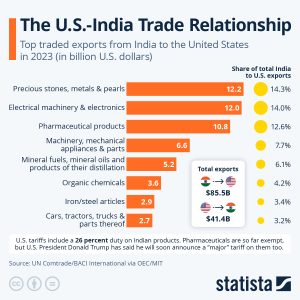
Top Traded Commodity Types Between India and the United States
This reflects the different purposes of the two media reports: the BBC focuses on conveying information clearly so that the audience can receive information quickly. The Diplomat tries to make the audience understand through this news and stimulate their thinking about the issue.
As I just mentioned, both of them use authoritative sources, but the emphasis and purpose of their use are different. The BBC mainly quotes data from mainstream economic institutions (such as the WTO and the World Bank) and uses direct statements from officials such as the Indian Minister of Commerce. These expressions focus on simplifying the news and visualizing it with official data, with the aim of making it easier for the audience to understand. The Diplomat, on the other hand, focuses more on presenting views through a political and economic analysis framework, citing a large number of think tank reports and academic literature, and using a large number of professional terms such as geopolitics, global trade, and global relations. This enhances the depth and credibility of the article, with the aim of triggering the audience to think more deeply about and discuss the issue. But I think both of them can add some charts about the comparison of the data to make the data more visual.
In terms of article narration, the BBC article uses interrogative sentences in structure to advance the narrative rhythm. However, what needs to be improved is that it does not add multimedia content such as videos, graphic reference boxes, and hyperlinks to the article, which is a major deficiency in digital news. Academic research points out that media information is a specific type of text and discourse. After analysis and research, it is shown that this theory and method can link the various attributes of the social and cultural background of news, and make the interpretation of news information more systematic and clear (Teun A. van Dijk, 1991) thereby promoting audience participation and thinking.
In contrast, although The Diplomat is also mainly text-based, it will add some related article links and author profiles to enhance the audience’s reading experience and promote audience understanding.

About author of The Diplomat
Online Delivery & Technical Delivery Analysis
BBC articles use a simple web interface with a clear structure but weak interactivity. Although the article contains built-in links and author signatures, there is no comment area, social sharing buttons or other multimedia elements except for a title image. This is in line with the BBC’s serious and authoritative image positioning, but it is relatively conservative in the interactivity of news in digital media.
In contrast, The Diplomat has added social sharing buttons, author information and a “related reading” module to increase user engagement. However, it also lacks multimedia content such as audio and graphics, which limits readers’ immersive reading experience. Although it is better than the BBC in terms of overall digitalization, it still focuses on digging into the depth of the text and does not give full play to the role of multimedia.
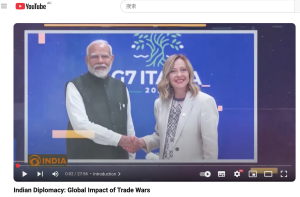
Indian Diplomacy: Global Impact of Trade Wars
Conclusion
By comparison, we can see that although the BBC and The Diplomat report on the same topic of India-US trade, they use different presentation methods and provide completely different user experiences.
First, due to the different institutional positioning of each, the two articles have different styles. The BBC emphasizes that the content is concise and easy to understand, suitable for public reading, which conforms to its public service function; while The Diplomat pays more attention to in-depth analysis and professionalism, which is more in line with the needs of its professional audience.
In terms of content layout, the BBC is good at authoritative reporting, but it is slightly lacking in interactivity and visual expression. Although The Diplomat is visually simple, it makes up for this with rich backgrounds and clear positions.
From an academic perspective, the two embody two different modes of digital news: the BBC emphasizes the breadth of dissemination, while the Diplomat pays more attention to professional depth.
Overall, The Diplomat provides a more intellectual reading experience for professional readers who pay attention to policies, while the BBC is more suitable for the general public who seek authoritative and concise information. Both play an important role in the evolving news media: one shapes opinions and the other conveys information.
Primary News Sources
“Trump tariffs: Will India open up its markets?” (2025, April 3). BBC News. https://www.bbc.com/news/articles/cd0nr05yxmzo
Khan, K. H. (2025, April 4). The India-US trade dilemma: Tariffs, tensions, and the road ahead. The Diplomat. https://thediplomat.com/2025/04/the-india-us-trade-dilemma-tariffs-tensions-and-the-road-ahead/
Reference:
Drew, T. (2024, March 12). The BBC adapts to changing audience demographics. Mumbrella. https://mumbrella.com.au/the-bbc-adapts-to-changing-audience-demographics-842987
Encyclopaedia Britannica. (n.d.). British Broadcasting Corporation. https://www.britannica.com/money/British-Broadcasting-Corporation
London Museum. (n.d.). History of the BBC. London Museum. https://www.londonmuseum.org.uk/collections/london-stories/history-of-the-bbc/
Media Bias/Fact Check. (2024). The Diplomat magazine. https://mediabiasfactcheck.com/the-diplomat-magazine/
Mediaweek. (2020, October 27). BBC reveals its biggest global audience ever: 468M a week. https://www.mediaweek.com.au/bbc-reveals-its-biggest-global-audience-ever-468m-a-week/?utm_source
van Dijk, T. A. (2000). Media contents: The interdisciplinary study of news as discourse. In R. T. Craig & H. L. Semetko (Eds.), Media, Politics and Culture (pp. 108–122). Routledge. https://www.taylorfrancis.com/chapters/edit/10.4324/9780203409800-8/media-contents-teun-van-dijk
Pictures and Video:
BBC. (2024, May 23). BBC Global Audience Measure 2024. https://www.bbc.com/mediacentre/2024/bbc-global-audience-measure
DW News. (2024, March 10). India-US trade relations: Tariffs and tensions explained [Video]. YouTube. https://www.youtube.com/watch?v=XkB6ovZOB8s
Khan, K. H. (2025, April 4). The India-US trade dilemma: Tariffs, tensions, and the road ahead. The Diplomat. https://thediplomat.com/2025/04/the-india-us-trade-dilemma-tariffs-tensions-and-the-road-ahead/
“Trump tariffs: Will India open up its markets?” (2025, April 3). BBC News. https://www.bbc.com/news/articles/cd0nr05yxmzo
Visual Capitalist. (2024, February 28). Top traded commodity types between India and the United States [Chart]. Statista. https://www.statista.com/chart/33174/top-traded-commodity-types-between-india-and-the-united-states/

Be the first to comment